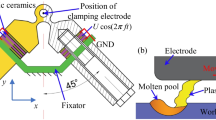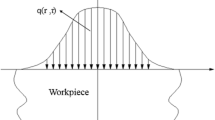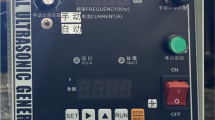Abstract
Compared with traditional EDM, ultrasonic vibration-assisted electric discharge machining (UEDM) technology provides excellent machining results for difficult-to-machine materials. There are many factors influencing the material processing. Ultrasonic cavitation bubble collapse has a big impact on UEDM processing. In this study, the influences of shock wave, high temperature, and pressure environment generated by collapse of cavitation bubble on workpiece surface are analyzed. The outer wall movement model of cavitation bubble under ultrasonic action is derived based on the Rayleigh-Plesset bubble dynamics equation. The effect of individual cavitation bubble from the initial state to collapse is simulated in order to reveal the changing trend of surface quality. According to the analysis of experimental and simulation results, it is found that the surface quality of EDM workpiece with ultrasonic cavitation effect is better than that of ordinary EDM. After the addition of ultrasonic, the surface roughness value of the workpiece is reduced by 9.3%–27.9%, while the ultrasonic cavitation effect reduces the surface roughness value of the workpiece by about 17.0%.










Similar content being viewed by others
Data availability
All data generated or analyzed during this study are included in this published article.
References
Wang Y, Liu ZQ, Shi J, Dong YH, Yang S, Zhang XF, Lin B (2020) Analysis of material removal and surface generation mechanism of ultrasonic vibration–assisted EDM. Int J Adv Manuf Technol 110(1–2):177–189. https://doi.org/10.1007/s00170-020-05769-x
Wang Z, Zhang H, Qian SQ (2017) Research on ultrasonic composite special processing technology and its development trend. Modern Manuf Eng 01:157–162
Che JT, Zhou TF, Zhu XJ (2016) Experimental study on horizontal ultrasonic electrical discharge machining. J Mater Process Technol 231:312–318. https://doi.org/10.1016/j.jmatprotec.2016.01.003
Schubert A, Zeidler H, Hackert-Oschatzchen M, Schneider J, Hahn M (2013) Enhancing micro-EDM using ultrasonic vibration and approaches for machining of nonconducting ceramics. J Mech Eng 59(3):156–164. https://doi.org/10.5545/sv-jme.2012.442
Hoang KT, Yang SH (2013) A study on the effect of different vibration-assisted methods in micro WEDM. J Mater Process Technol 213:1616–1622. https://doi.org/10.1016/j.jmatprotec.2013.03.025
Zhao WS (2003) Advanced EDM Technology. National Defense Industry Press, Beijing
Guo ZN, Li DC, Yu DM (1999) Research and exploration of ultrasonic-assisted EDM wire-cutting process. Electr Process Tooling 6:9–12
Xu MG, Zhang JH, Zhang QH, Ren SF (2006) Research on ultrasonic vibration-assisted gas dielectric EDM. China Mech Eng 17(14):1447–1450
Endo T, Tsujimoto T, Mitsui K (2008) Study of vibration-assisted micro-EDM—the effect of vibration on machining time and stability of discharge. Precis Eng 32(4):269–277. https://doi.org/10.1016/j.precisioneng.2007.09.003
Gu S (2012) Research on the CNC system of ultrasonic-assisted discharge milling five-axis composite machining machine Dissertation. Tianjin University
Goiogana M, Sarasua JA, Ramos JM, Echavarri L, Cascon I (2016) Pulsed ultrasonic assisted electrical discharge machining for finishing operations. Int J Mach Tools Manuf 109:87–93. https://doi.org/10.1016/j.ijmachtools.2016.07.005
Qi L (2017) Research on the basic process of ultrasonic vibration working fluid compound EDM Dissertation. Dalian University of Technology
Shitara T, Fujita K, Yan JW (2020) Direct observation of discharging phenomena in vibration-assisted micro-electrical discharge machining. Int J Adv Manuf Technol 68:76–80. https://doi.org/10.1007/s00170-019-04877-7
Gao X, Li JC, Xing QX, Zhang QH (2022) Research on ultrasonic vibration–assisted electrical discharge machining SiCp/Al composite. Int J Adv Manuf Technol 121:2095–2113. https://doi.org/10.1007/s00170-022-09352-4
Funding
This work supported by the Natural Science Foundation of Tianjin City (18JCQNJC05200) and Tianjin Municipal Education Commission (2018KJ116).
Author information
Authors and Affiliations
Contributions
All authors contributed to the study conception and design. Material preparation, data collection, and analysis were performed by Yan Wang, Lingfeng Fan, Jian Shi, Yinghuai Dong, and Zhiqiang Fu. The first draft of the manuscript was written by Lingfeng Fan, and all authors commented on previous versions of the manuscript. All authors read and approved the final manuscript.
Corresponding author
Ethics declarations
Ethics approval
Not applicable.
Consent to participate
Not applicable.
Consent for publication
Not applicable.
Competing interests
The authors declare no competing interests.
Additional information
Publisher's note
Springer Nature remains neutral with regard to jurisdictional claims in published maps and institutional affiliations.
Rights and permissions
Springer Nature or its licensor (e.g. a society or other partner) holds exclusive rights to this article under a publishing agreement with the author(s) or other rightsholder(s); author self-archiving of the accepted manuscript version of this article is solely governed by the terms of such publishing agreement and applicable law.
About this article
Cite this article
Wang, Y., Fan, L., Shi, J. et al. Effect of cavitation on surface formation mechanism of ultrasonic vibration-assisted EDM. Int J Adv Manuf Technol 124, 3645–3656 (2023). https://doi.org/10.1007/s00170-022-10780-5
Received:
Accepted:
Published:
Issue Date:
DOI: https://doi.org/10.1007/s00170-022-10780-5




